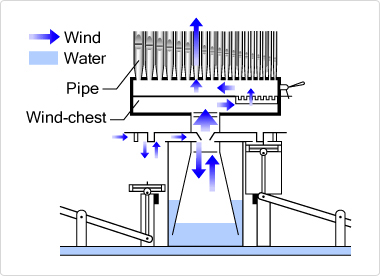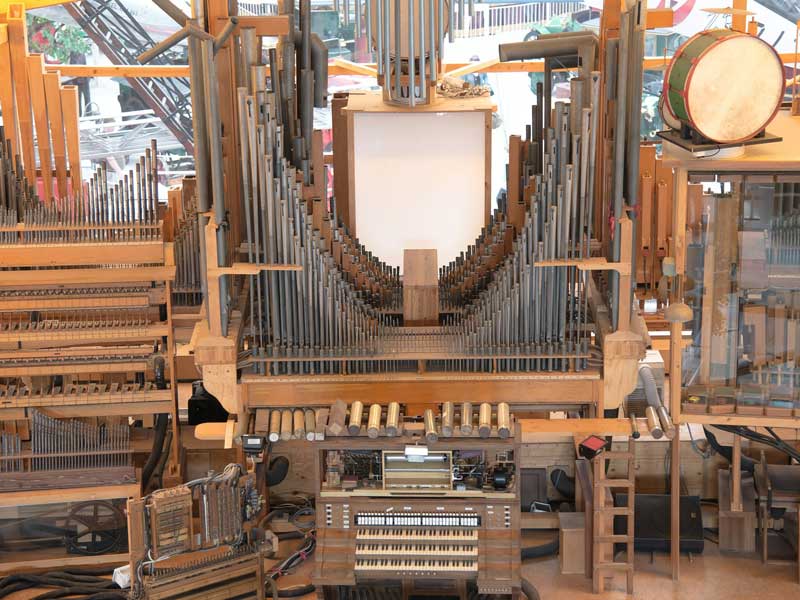What is the water pressure organ in bony fish. The first organ used water to control wind pressure.
The Origins Of The Pipe Organ The Birth Of The Pipe Organ Musical Instrument Guide Yamaha Corporation
The pipe organ is a musical instrument in the wind instrument family.

. The water goes down on that side of the tube and up on the other. The Halberstadt organ was the first instrument to use a chromatic key layout across its three manuals and pedalboard although the keys were wider than on modern instruments. Of course it was a device specifically constructed for that purpose and had features to prevent getting water in the wind chest.
Inches of Wind Pressure - What is it all about. 101 the jet breaks up for it was noticed also that no sustained oscillation or only one of very small amplitude was. Compressed air shown in green is forced by the pump A into the air vessel B.
The organ is a _____instrument whose tone is produced by wind flowing through _____. Did The first organ use water to control wind pressure. Please select the word pair that best completes the following sentence.
The function of the organs stops is to. Here is a cross sectional diagram of a typical pipe organ pressure regulator one design that has been used in a number of leading pipe organs. According to one theory the water organ mechanism was not originally developed with the intention of creating a musical instrument but instead was invented as a.
Organ wind pressure is much lower and we measure it as inches on a water column Picture a clear glass tube in the shape of a U that is twenty-inches high. The earliest pipe organs are thought to have been water organs or hydrauli developed at that time in northern Africa. Wind Pressure on the Pitch of Organ Pipes.
During the 1800s most organs used a water based system that forced water and air into a series of tubes to create the pressure and Calcants were abandoned due to their cost of wage and the training required to perform the duty properly. Fill it halfway with water and apply pressure to one side of the U. Also they do it all the time and are quite skilled professionals.
It had twenty bellows operated by ten men and the wind pressure was so high that the player had to use the full strength of his arm to hold down a key. The first organ used water to control wind pressure. Hence its name hydraulis literally water driven pipe instrument.
This early organs wind supply was created by water pressure. This is precisely why the ancient predecessor of the pipe organ invented by Ctesibius of Alexandria in the 3rd century BC was known as a hydraulis. Air from the blower enters through the bottom inlet into the internal valve box section after which it passes through.
A hydraulis is an early type of pipe organ that operated by converting the dynamic energy of water Ancient Greek. 5 rows The first organ used water to control wind pressure. Johnson Son are credited with being one of the first organ builders in the USA to use a water motor to provide the organs wind supply.
Ctesibius of Alexandria devised a system of wind pressure regulation using water in the second century BCE but primitive forms of the organ pre-date this by at least a century. Organ stops are voiced on all kinds of wind pressures. To find the origins of the pipe organ we must travel back through time to ancient Greece.
The piston grey is shown at the top of its stroke. While the regulator is always seeking to stabilize the wind pressure the tremulant is engaged to quickly release air from the regulator at short set intervals. Is the accordion a.
Húdōr into air pressure to drive the pipes Ancient Greek. In the Greco-Roman arena. Many organ stops are speaking on only 2-3 inches.
Bellows were used to supply wind by the 6 th and 7 th century AD. The HydraulicusWater Organ Described by Vitruvius circa AD. Control the flow of air to the pipes.
The Orgelbau Klais workers used a manometer of water to measure the wind pressures. The air vessel is nearly empty of water blue and the surrounding water chest C is nearly full. A pipe organ feeds wind into pipes causing the air to oscillate and produce a sound.
The pipe organ is derived from the water organ in the 3 rd century BC in Ancient Greece. A wind pressure of 50 inches of water would be extremely high. The first examples of pipe organs with the basic features of today can be traced to the third century BCE.
The pipes stand in line above the box referred to as the wind-chest with wind fed from below into the pipes the organist wishes to use to produce sound. The operating principle is as follows. Refer to figure nine above.
The tremulant is the single-most important device for creating the heavy vibrato sound so uniquely characteristic of the theater organ. Before the invention of bellows early pipe organs relied on water cisterns to control wind pressure. By the mid 1900s electric blowers were common and were the primary source of wind for pipe organs.
It is said to have been invented by Ktesibios of Alexander and contained a mechanism to supply air under pressure a wind-chest to store and distribute it keys and valves to admit wind to the pipes and one or more graded sets of fixed. Please select the word pair that best. In the 12 th century the instrument advanced further and by the 1600s the majority of the sounds.
This means that the pressures at which most organ pipes operate are easily within the. Hydraulis 1st century BC Archaeological Museum of Dion Greece. Each tremulant works in conjunction with a regulator.
This type of hydraulic motor depended on a reliable water supply of sufficient pressure to operate a water wheel which was connected to the bellows through a series of shafts wheels and gears.

The Theater Organ Then And Now History Of The Organ

Organ Definition History Types Facts Britannica

The Origins Of The Pipe Organ The Birth Of The Pipe Organ Musical Instrument Guide Yamaha Corporation
0 Comments